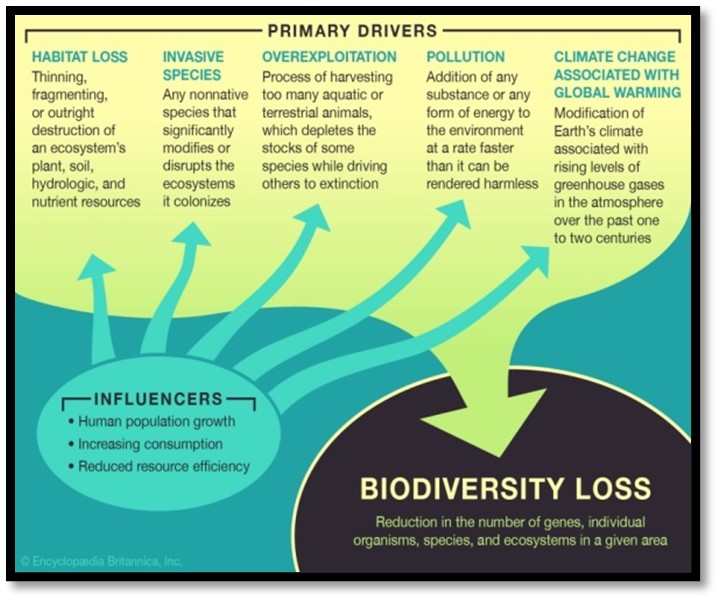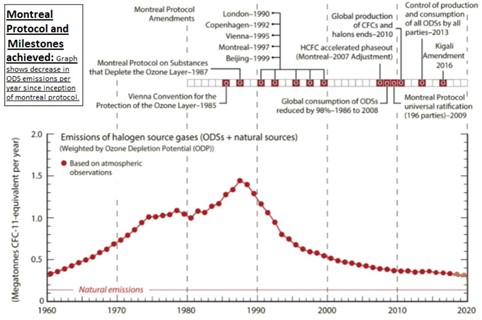23 Oct
Skill development in India-Need, Challenges & Opportunities
- In news: The skills development ministry decided to set up a committee of experts to consider the evaluation of the National Policy on Skill Development and Entrepreneurship, 2015 policy, to make necessary recommendations to ensure better outcomes and to match global standards.
- Background:

-
- With the advent of the Fourth Industrial Revolution (Industry 4.0) and changing industrial landscape, skill requirements will have to focus on developing 21st century skills among fresh and existing workforce.
- As structural, demographic and technological shifts transform the Indian economy and the nature of work, the labour force will have to be skilled and made employable. Strategies for re-skilling and increasing the skills of the current workforce, as well as formal recognition of informally acquired skills, will also have to be reinforced.
- Regional perspective: Diverse physiographic conditions, like hill regions, northern plains, dry regions, coastal plains etc. results in diversity of skill demand and requirements of skill development across length and breadth of the country.
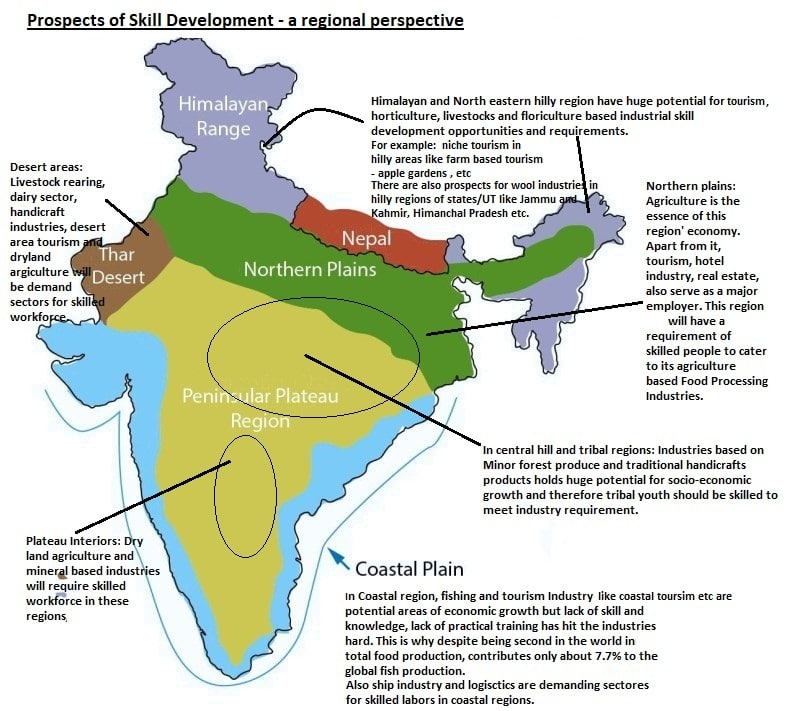
- Opportunities for India:
- India has 5% of its population in the age group of 15-59 yearswhich will peak around 2036 when it will reach approximately 65%. Thus has a unique window of opportunity for another 20-25 years called the “demographic advantage”. If India is able to skill its people with the requisite life skills, job skills or entrepreneurial skills, the demographic advantage can be converted into the dividend wherein those entering labor market or are already in the labor market contribute productively to economic growth both within and outside the country.
- India’s burgeoning young workforce of 830 million can be an asset not just for India but for the aging developed world, provided it is nurtured and prepared for the future: opportunities for the migration of skilled persons from India to the benefit of both the host and destination countries.
- Challenges in skill development ecosystem in India:
- Existing socio-economic inequalities and pull factor migration results in regional disparities like:
- Vertical disparities: Those at bottom of social ladder are denied access to skill building because of rigid social systems and limited economic resources.
- Horizontal disparities: Education, health and income disparities limit the access to skill development and up-gradation in backward and less developed regions of the world.
- Existing socio-economic inequalities and pull factor migration results in regional disparities like:
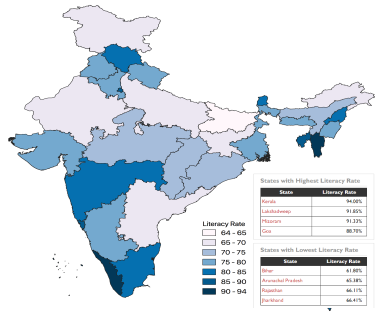

-
- Other challenges: The skill development issue in India is pertinent both at the demand as well as supply level.
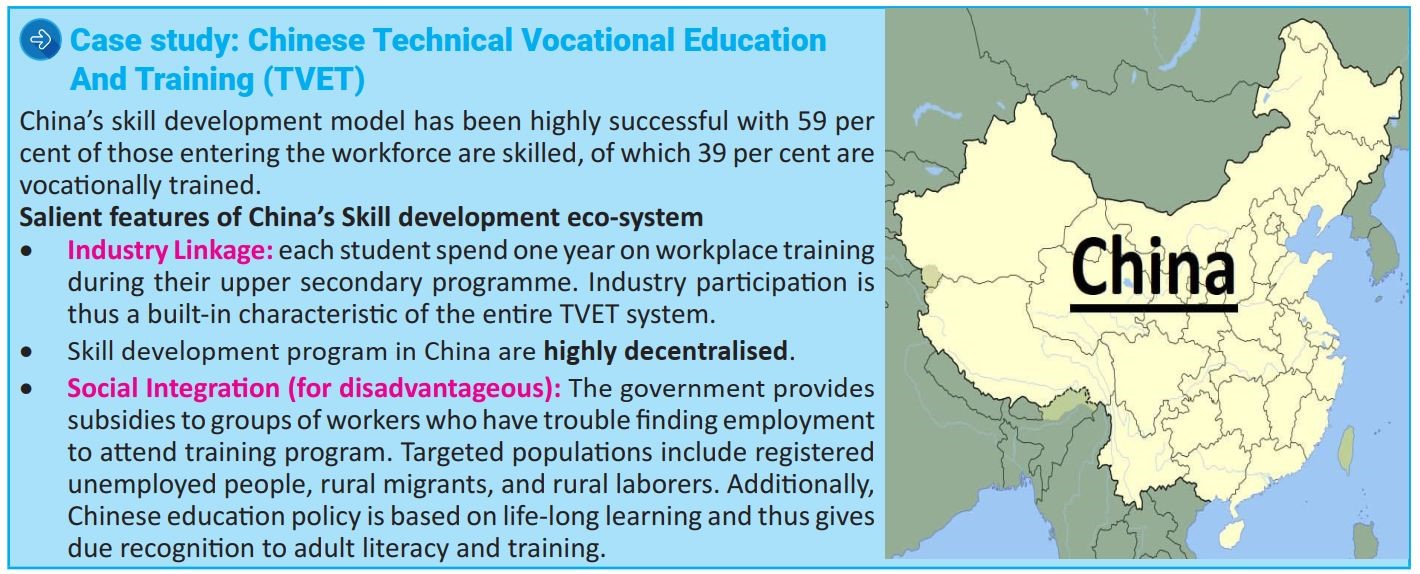
- Way forward:
- Challenges related to huge informal economy could be addressed by developing clusters or lead firm taking the initiative which would help achieving economies of scale in the skills development.
- Connecting basic education to technical training, technical training to labor market entry, and labor market entry to workplace and lifelong learning.
- Encouraging international mobility:
Technical collaborations have been undertaken with countries such as the Japan, UK, Australia and the UAE for government-to-government and B2B partnerships to increase the mobility of Indian workers.
-
- Empowerment through gender sensitization, creation of economic opportunities and economic and social support.
- Conclusion:
Skill development is crucial to achieve the 2030 Global Agenda for Sustainable Development and hence forms a major focus in following SDG Goals.
-
- SDG4: to “ensure inclusive and equitable quality education and promote lifelong learning opportunities for all.”
- SGD 8: By 2020, substantially reduce the proportion of youth not in employment, education or training.
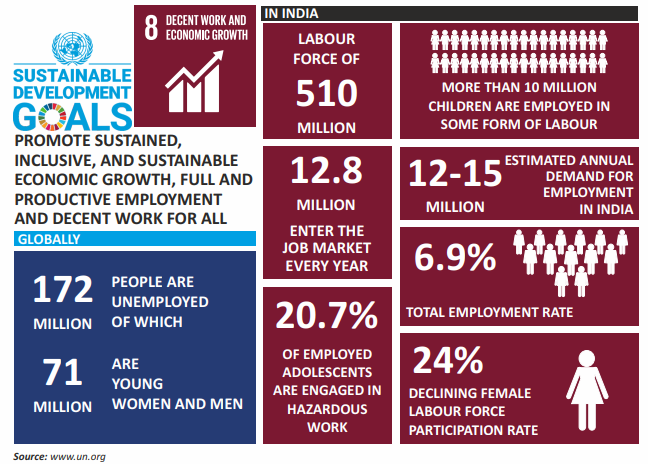
Where it can be used?
- Paper1- Settlement (urbanization), Regional planning (Growth centers\pole, Regional imbalances, Sustainable development).
- Paper2 -Settlement (urbanization), Regional development and Regional Planning.
Sources:
- 1) Schemes & Initiatives through NSDC
- 2) OVERVIEW OF INDIA’S EVOLVING SKILL DEVELOPMENT LANDSCAPE
- 3) Implementation of Seekho aur Kamao (Learn & Earn)
- 4) The 3 challenges to skill development in India – and how to tackle them
- 5) Skill Development and Training
- 6) Skill development in India
- 7) Skill development for accelerating the manufacturing sector: the role of ‘new-age’ skills for ‘Make in India’
Offshore wind energy in India- Prospects and Need
Why in news: Till date, no single offshore wind energy project has commenced in India. Are we towards the target of 30 GW by 2030?

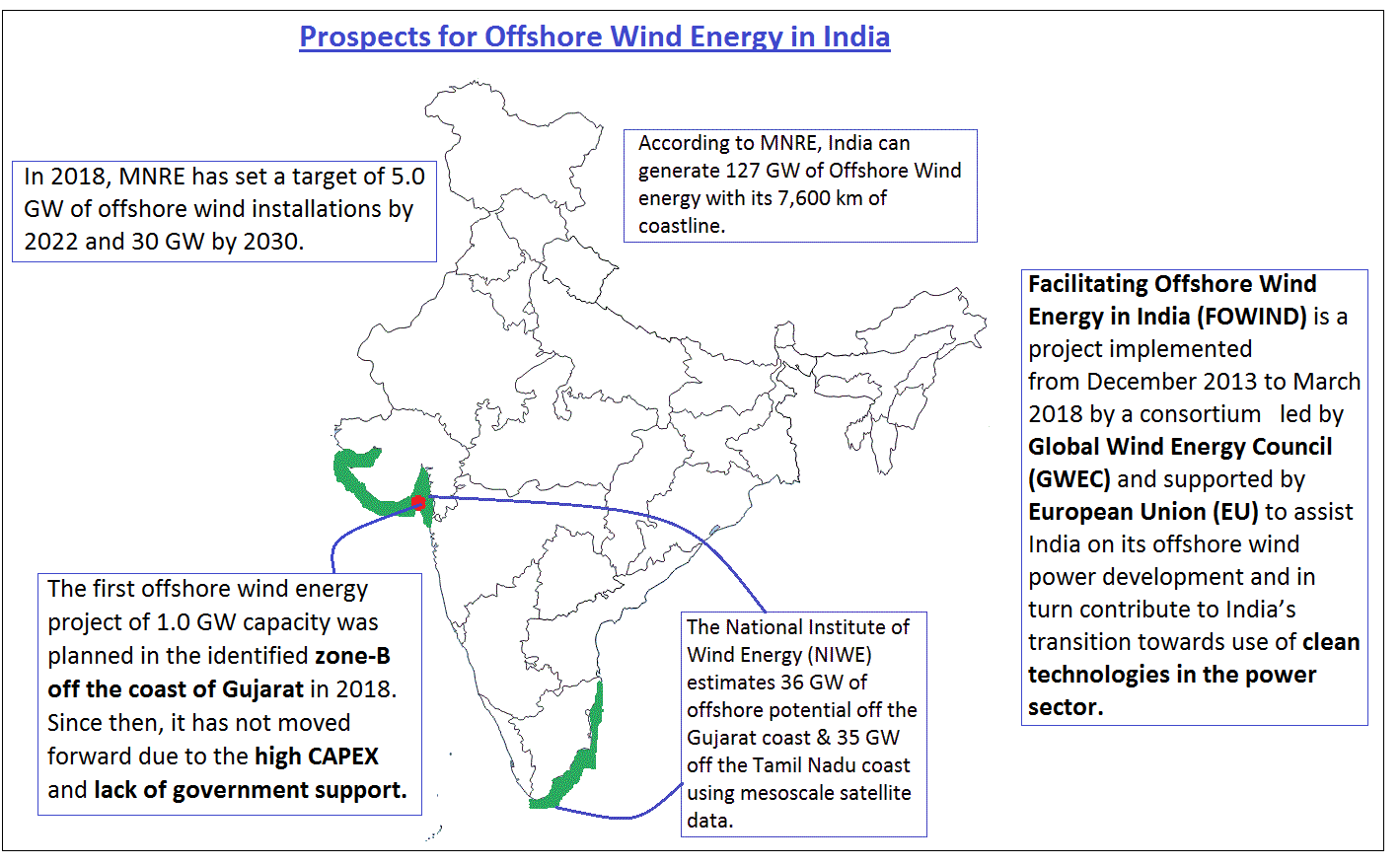
The need for focusing on offshore wind energy in India:
- Less availability of area on land: In India, where land is limited and the population is increasing, large wind farms positioned over water bodies will be vital.
- High efficiency: Offshore wind turbines are more efficient compared to onshore turbines. Wind speed over water bodies is high & is consistent in direction. As a result, offshore wind farms generate more electricity per installed capacity. Also fewer turbines are required to produce the same capacity of energy as compared to onshore ones.
- High reliability: As offshore wind farms have a higher capacity utilization factor (CUF), they allow for longer operating hours. Also they are usually located near to the cities and load centers. Thus, transmission losses are minimized.
- Lesser disputes: Offshore wind farms prevent social conflicts which arise due to competitive land uses.
- Environmental benefits: As any other renewable energy source, offshore wind farms do not require the consumption of water to operate properly, and also do not emit any environmental pollutants or greenhouse gas emissions during its operation thereby helping us in fighting climate change & will pave way for the sustainable development.
- To meet INDC: It will help in achieving one of India's INDC under Paris agreement i.e. to achieve about 40 per cent cumulative electric power installed capacity from non-fossil fuel based energy resources by 2030.
- Energy security: Domestic offshore wind energy production will reduce the need for energy imports and diversify our energy basket and consequently reduce our dependence on exporter countries.
Way Forward:

- Facilitating Offshore Wind in India (FOWIND) project classifies five "action items" that are critical to implementation of offshore wind in India. Those are:
- Development of a long-term offshore roadmap.
- Clear consenting and permitting procedures.
- Regional and national grid development.
- Financial support mechanisms.
- Development of skills and competences.
- Along with the above action items, strong political will is needed to tap this unexplored market. g. Strong political will of self-reliance towards energy security backed with relevant policy made UK as the global market leader in the offshore wind energy segment.
Where it can be used?
It can be used in topics related to Paper 1 (Energy Crisis, Sustainable development), Paper 2 (Renewable energy resources, Sustainable growth) and GS 3 (Energy).
Sources:
Coal Crisis in India-The Road Ahead
Why in news: The world is facing an energy crunch as the supply of natural gas, coal and other energy sources fails to adequately satisfy demand. India’s power plants are also running on critically low coal stocks.
Reasons for current coal crisis in India:
- Sharp uptick in power demand: Economy recovering from the Covid-19 pandemic coupled with supply issues have led to the current coal shortage. India consumed 124 billion units of power in August 2021 compared to 106 billion units of power in August 2019 which didn’t dwindle due to pandemic.
- Heavy rainfall and floods: Lower than normal stock accumulation by thermal power plants in the April-June period and continuous rainfall in coal mining areas in August and September which led to lower production and fewer dispatches of coal from coal mines (supply crunch).
- Over dependence on coal energy: Coal-fired plants make up huge amount of India’s power source mix. Also, these plants only have supplied the higher proportion of increased power demand post-pandemic which led to faster depletion of coal stocks.
- High import dependency: As we have high import dependency on coal for our energy needs, a consistent move to lower imports coupled with high international prices of coal has led to plants cutting imports.
- Declining water resources: Groundwater levels across India are in decline. This is a major threat for coal generation, which requires substantial amounts of water for steam production and cooling, and has already led to production cuts at several plants on a number of occasions.
- Mining Monopoly: It should also be noted that the mining of raw materials such as coal is nearly monopolized by public sector companies like CIL that are not run primarily for profits. In fact, CIL has kept the price of its coal low even as international prices have risen significantly.
- Traditional loopholes: Such as less availability of coking-grade coal, out dated coal technologies, slower transportation due to lack of dedicated freight corridors and coal mafia etc.
- High indebtedness of power distribution companies: DISCOMs’ strained balance sheets have consistently triggered delayed payments to power producers, often affecting cash flows and dis-incentivizing further investment in the electricity generation sector.
- Inadequate mining exploration: Legacy of nationalization and the long monopoly of government-owned Coal India Limited has resulted in inadequate exploration and mining of the mineral leading to shortage of coal.
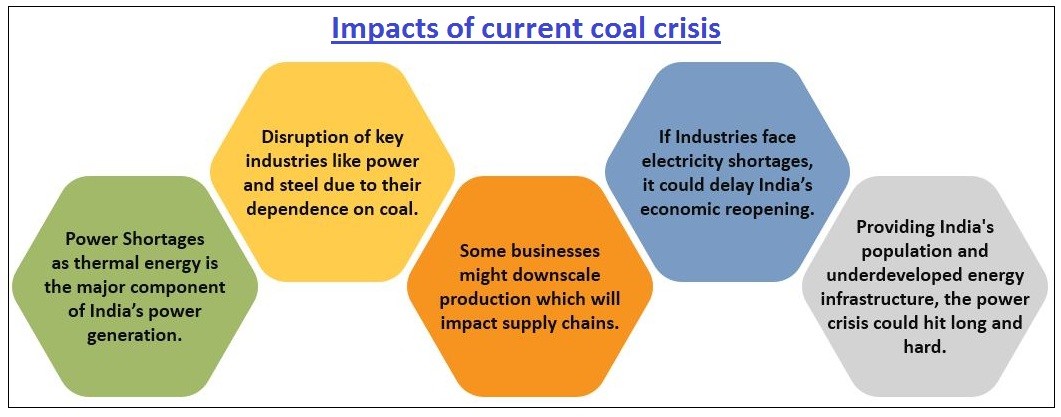
The road ahead/way forward:
Short-term measures:
- Ramp-up mining: Government is working to closely monitor stocks and also State run Coal India and NTPC are working to raise output from mines to boost supply.
- Supply controls: Rationing domestic power supplies, especially in rural and semi-urban areas, may emerge as one of India’s short term
- Turn to Natural Gas Powered Generators: In a desperate situation, the natural gas-powered fleet could help prevent any widespread power outages.
Long-term measures:
- Fuller Dams: The same monsoon rains that have flooded coal mines are likely to boost hydro-power generation. Large hydro-electric projects on dams are India’s major electricity source after coal and the sector performs at its peak around the rainy season which typically extends from June to October.
- Technology Upgradation measures to be imposed to improve the productivity of the coal mines and improve recovery from the coal mines.
- UDAY (Ujwal DISCOM Assurance Yojana) Scheme: Launched in 2015 to improve the financial health of DISCOMs which in turn improves the financial health of power producers and coal mining companies.
- Diversification of energy basket: Diversifying our power mix with renewable energy sources like solar and wind energies will reduce our dependence on coal. This will also help us in fighting climate change and paving way for sustainable development.
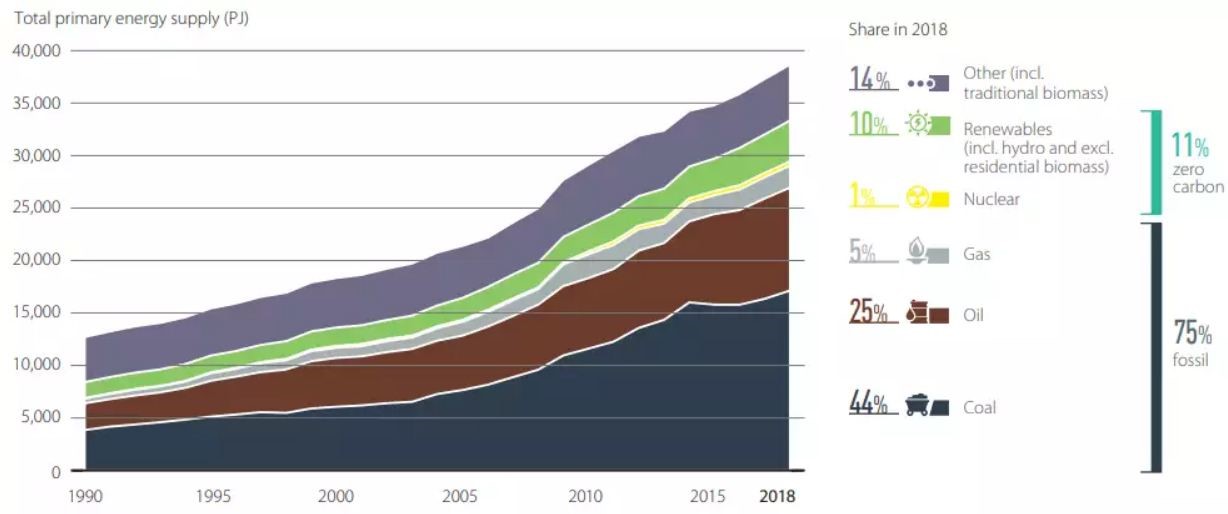
Where it can be used?
This can be used in topics related to Paper 1 (Energy Crisis), Paper 2 (Energy, Minerals, Energy Crisis, and Industries) and GS3 (Energy).
Sources:
National Bamboo Mission (NBM) - Edukemy Current Affairs
- It was first launched in 2006 & the restructured NBM was launched in 2018-19 for holistic development of the bamboo sector through a cluster-based approach in a hub and spoke model.
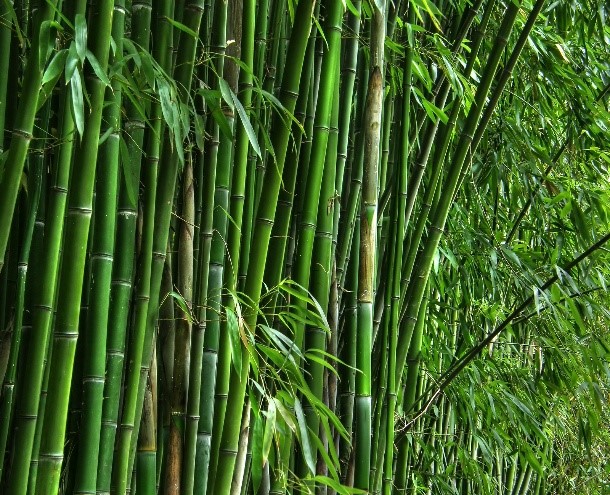
- NBM will be a sub scheme of National Mission on Sustainable Agriculture (NMSA) under the umbrella Krishonnati Yojana & implemented by Ministry of Agriculture and Farmers Welfare.
- Key objectives: To increase the area under bamboo cultivation using improved high yielding varieties, to promote growth through area based regionally differentiated strategies, providing backward and forward linkages- linking farmers to markets, to promote marketing of bamboo based handicrafts, employment generation and induction of modern technology into the bamboo sector.
- Funding pattern: 60:40 between centre and state govt. for all states excepting NE & Hilly states, where it would be 90:10 and 100% in case of UTs/ R&D institutes/Bamboo Technology Support Groups (BTSGs) and National level agencies.
- Coverage: The mission will focus on development of bamboo in limited states where it has social, commercial and economic advantage, particularly in the North East Region and some other states.
Source:
Basel Convention:
- It is an international treaty that was designed to reduce the movements of hazardous waste between nations, and specifically to prevent transfer of hazardous waste generated from developed countries & transported to least developed countries (LDCs).

- The convention is also intended to minimize the rate and toxicity of wastes generated, to ensure their environmentally sound management as closely as possible to the source of generation, and to assist LDCs in environmentally sound management of the hazardous and other wastes they generate.

- It covers hazardous wastes that are explosive, flammable, poisonous, infectious, corrosive, toxic or eco-toxic. In 2019, it was amended to include plastic waste as regulated material. However, it does not address the movement of radioactive waste.
- The Basel Action Network (BAN), based in Washington, is a charitable civil society NGO that works as a consumer watchdog for implementation of the Basel Convention.
Source:
Speleothem
- Definition: The word speleothem is derived from the Greek words spelaion meaning "cave" and thema meaning "deposit". It is a geological formation by mineral deposits that accumulate over time in natural caves in karst landscape. They are secondary mineral deposits formed in caves by flowing, dripping, ponded, or seeping water and are most commonly form in calcareous caves due to carbonate dissolution reactions.
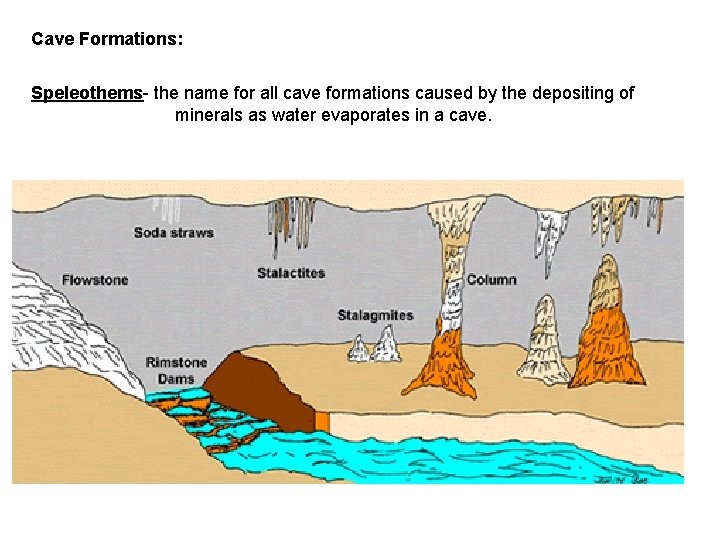
- Types of speleothems: Two most common types of speleothems are stalactites and stalagmites- Stalactites grow down from the cave ceiling, while stalagmites grow up from the cave floor.
- How are they formed: Speleothems are primarily composed of calcium carbonate
- Factors determining formation of speleotherms:

Two important factors are the temperature outside (which affects the rate of decay of plants and animals, hence the amount of carbon dioxide in the soil), and the amount of rainfall.
- Found in karst landscape in regions like Chalk Area of England and France, Florida(USA), etc.
- Significance:
Are resource/mineral rich and most commonly occurring minerals are calcite, aragonite, and gypsum although many other minerals have been found in speleothems in minor amounts.
NECTAR – Strengthening S&T for the regional development in NER
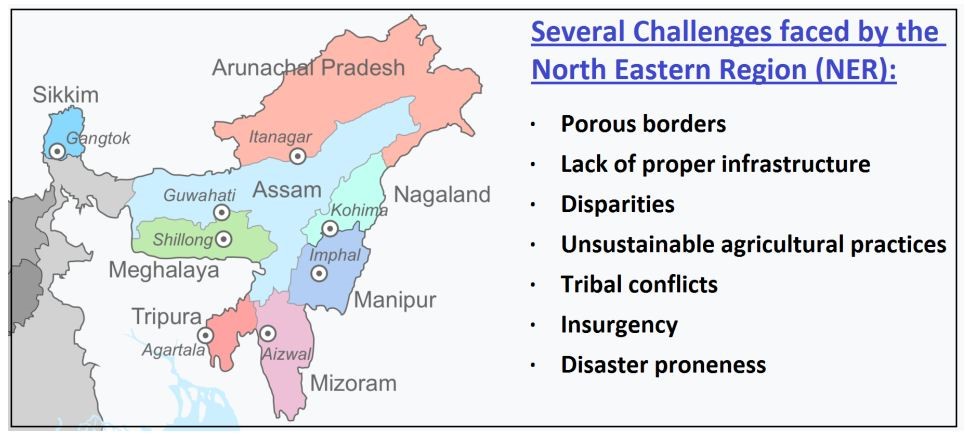

Several technological measures taken by NECTAR for the regional development in NER:
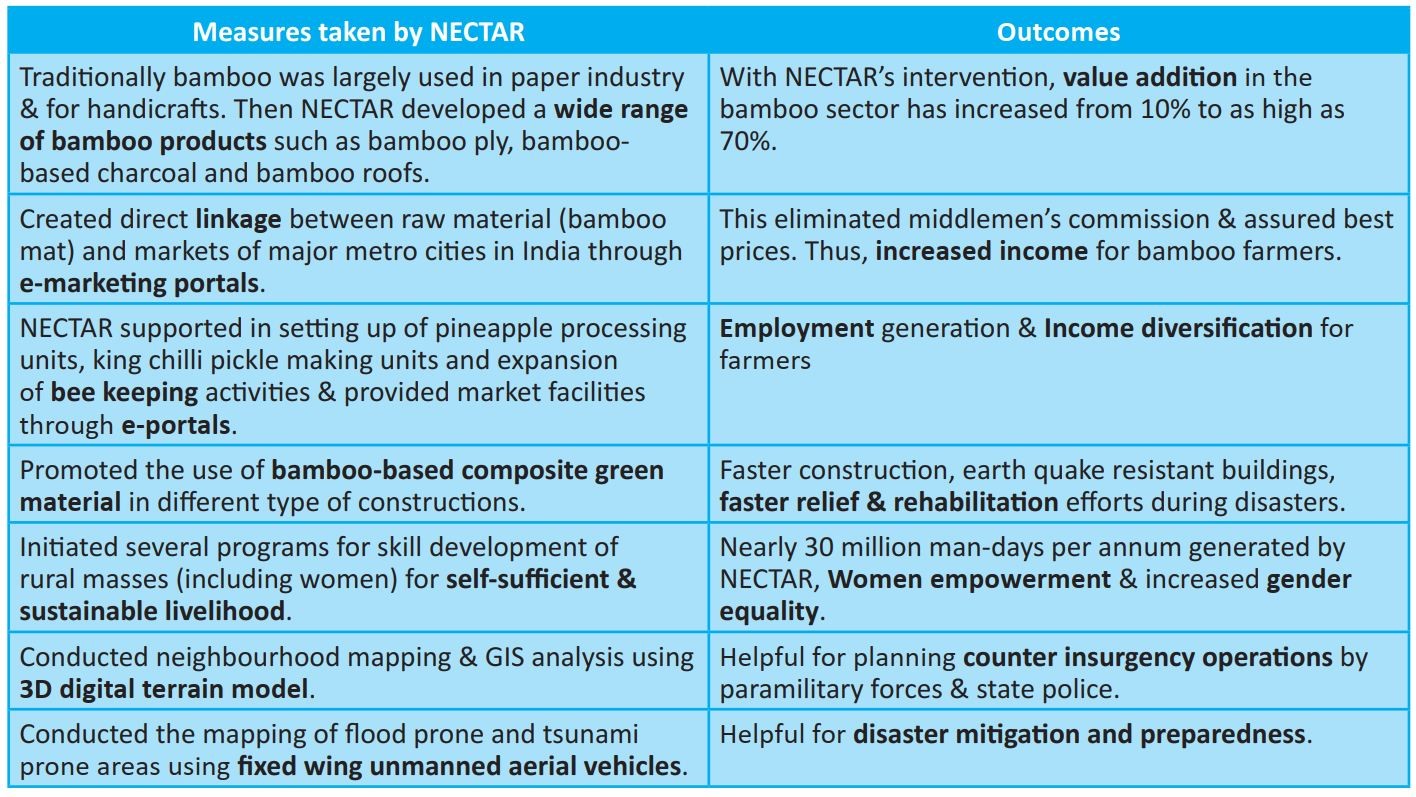
Where it can be used?
This can be used in topics related to Paper 2 (Agriculture, Rural area development) and GS3 (Applications of Science & Technology, Disaster management).
Source:
Places in news
|
Umangot River · Why in news: It is the cleanest river in the country, Ministry of Jal Shakti said in a tweet. · Popularly known as Dawki River & it is 100 kilometers from Shillong in Meghalaya. · It originates from the Eastern Shillong Peak and acts as a natural divide between Jaintia and Khasi hills, before finally flowing into Bangladesh. · It flows through a village called Mawlynnong (God's Own Garden) in Meghalaya, situated on India- Bangladesh border, which is touted as Asia’s Cleanest Village. · It serves as a busy trade route between India and Bangladesh. · Tropical evergreen forests are found along the banks of the river. |
|
Rajaji Tiger Reserve · Why in news: NTCA orders suspension of tourism in core habitat of Rajaji Tiger Reserve. · It is nestled between the Shivalik ranges and the Indo-Gangetic plains. · It spread across three districts of Uttarakhand: Haridwar, Dehradun and Pauri Garhwal. · Ganga and Song rivers pass through the reserve. · Vegetation here mainly includes Moist Shivalik Sal Forest, Moist Mixed Deciduous Forest, Northern Dry Mixed Deciduous and Khair-Sissoo forests. · Asiatic elephant and Bengal tiger are among the important fauna here. |
|
Kinnaur · Why in news: Kinnaur became the first fully vaccinated district in India. · It is located in the northeast corner of Himachal Pradesh bordering Tibet to the east. · Sutlej, Spiti and Baspa are the important rivers in the district. · Temperate climate with long winters found here. · Alpine vegetation found here. Important species: juniper, pine, fir, cypress, and rhododendron. · Kinnauri tribe found here. |
|
Hasdeo coal fields · Why in news: Tribes from Hasdeo Arand forest region are protesting against coal mining projects and illegal acquisition in the region. · They are located in the Korba district of Chhattisgarh. · It is situated in the catchment area of Hasdeo River, a tributary of Mahanadi. · Coal found here is of Gondwana type and mostly Non-coking coal. · Tropical moist deciduous forests found in this region. · Gond, Oraon, Lohar and Kunwar are the important tribes in the region. |
|
Idukki · Why in news: Gates of Idukki dam opened after 3 years due to heavy rainfall in several districts of Kerala. · Idukki district lies amid the Cardamom Hills of Western Ghats in Kerala. · Periyar and Cheruthoni are the important rivers in the district. · Climate: Monsoon type with short dry winters (Koppen, Amw) & a small part of the district falls under the rain shadow region of Western Ghats. · Shola forests found here. The district is also known as the "Spice Garden of Kerala". · Malampadaram, Malappulayan, Malayarayar, Urali, Muthuvan and Mannan are the important tribes here. |
|
Palani hills · Why in news: Mercury poisoning is threatening the bird white-bellied Sholakili, endemic to Palani Hills. · It’s a mountain range spread across the states of Tamil Nadu and Kerala. · Palani Hills joins with Anamalai Hills and Cardamom Hills at Anamudi peak in Kerala state. · Vandaravu peak is the highest peak in the Palani hills. · Its northern slopes are drained by the Shanmukha River, Nanganji River, and Kodavanar River, which are tributaries of the Kaveri River. · Kodaikanal hill station is part of Palani Hills. |

Share the article
Get Latest Updates on Offers, Event dates, and free Mentorship sessions.

Get in touch with our Expert Academic Counsellors 👋
FAQs
Geography Current Affairs focuses on the contemporary issues, events, and developments in the field of geography. It covers recent geographical phenomena, environmental changes, geopolitical shifts, and related news. This differs from regular geography studies which may focus more on foundational concepts, historical contexts, and theoretical frameworks.
Updates are provided regularly to ensure that subscribers stay informed about the latest developments in geography. Typically, updates are provided on a fortnightly basis, depending on the frequency of significant events and changes in the field.
Absolutely. Geography Current Affairs serves as a valuable resource not only for Geography optional but also for GS papers, especially GS Paper 1 (covering Indian Heritage and Culture, History, and Geography of the World and Society) and GS Paper 3 (covering Technology, Economic Development, Biodiversity, Environment, Security, and Disaster Management). It aids in building a holistic understanding of various topics and strengthens answer-writing skills by incorporating contemporary examples and perspectives.
Geography Current Affairs holds immense importance for UPSC preparation, particularly for aspirants opting for Geography optional. It helps candidates stay updated with the latest developments, geographical phenomena, environmental issues, and geopolitical shifts worldwide, aligning them with the dynamic nature of the subject as tested in the UPSC examinations.


